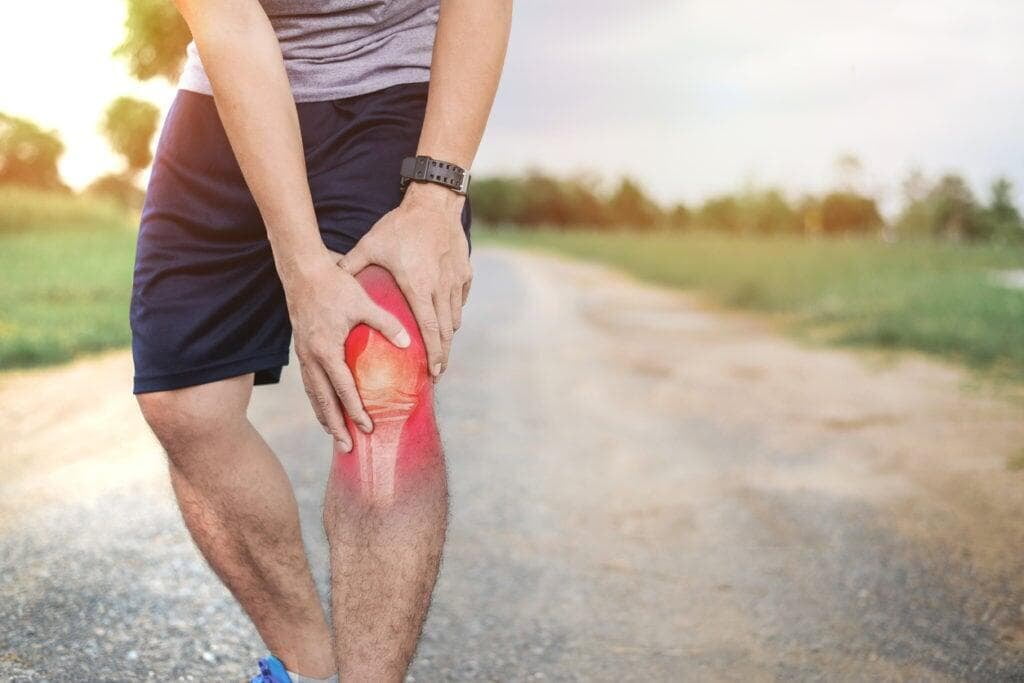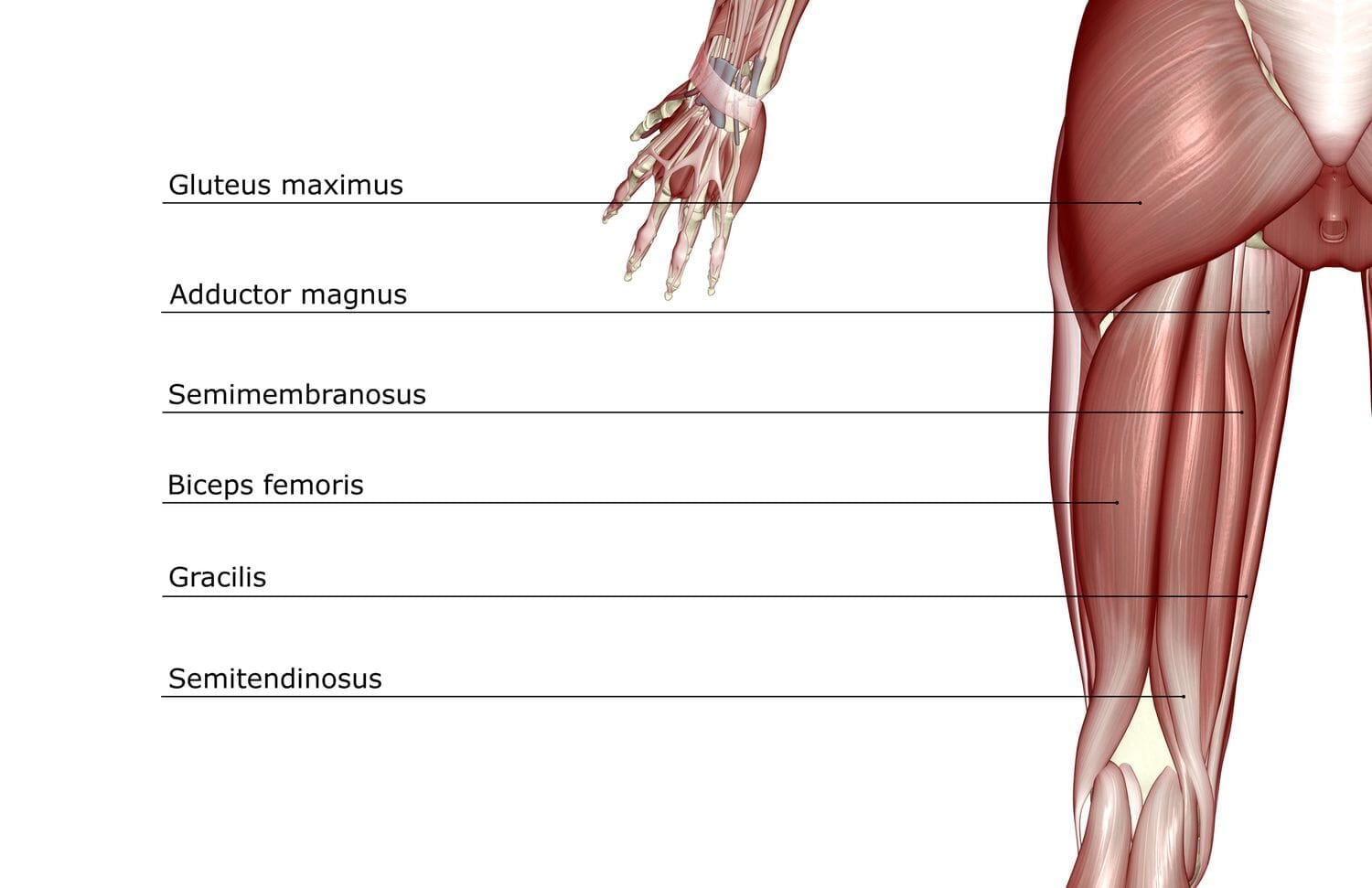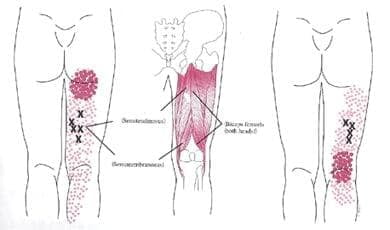Knee Pain and the Muscles of the Back of the Thigh

I know that from time to time we all get these mysterious pain sensations that seem to come out of nowhere. We have not done anything extreme, we didn't fall or hurt ourselves and yet our body is telling us there's something we need to pay attention to.
In my practice, I've seen many times where pain is caused by muscle dysfunction - our job or our hobbies over time cause muscle fatigue, and then the primary muscle that would normally flex or extend a muscle now is assisted more by secondary muscles and bound together with that muscle by connective tissue - fascia.
This fascial binding causes pulling and tension in areas of the muscle fibers which can cause "trigger" points that feel like tight balls within the muscle belly, or they can cause over stretch of muscle tendons that connect the muscles to the bone. They ultimately disrupt the normal pattern of movement of the muscles, as muscle tissue is supposed to glide on top of one another smoothly, but, with continued fascial binding the muscle no longer moves independently, but conjointly with other supportive muscles when it performs its function.
This causes further fatigue, muscle tension, soreness, and constant "pulling" of the muscle in ways that trigger our pain sensations.
To look at the knee in particular, we notice that there are a lot of different muscle structures that support our knee movement we'll start with the muscles in the back of the thigh:

Looking at each of these muscles individually will give you a little insight into their specific roles as it relates to the knee function, and which other muscles support this function, and therefore are called upon in times of muscle fatigue so you can see where fascial binding typically occurs.
Semimembranosus: This muscle originates from the pelvis and runs along the inside of the back of your thigh, and it's main function is to extend our hip. What does that mean? Hip extension occurs when our hip elongates and in typical day to day activities, this happens during walking. This muscle is responsible for allowing you to swing your leg behind you. When it's functioning properly, during walking, it allows you to keep your leg planted behind you long enough to take a normal stride. If you're noticing that your stride is short for your height, this muscle may need a little TLC.
The semimembranosus runs the whole length of our thigh, and attaches to the inside of the bottom of our knee (at the top of our calf area). And so it's also responsible for flexing our knee - or bending our knee. So you can see that with actions on both sides of the muscle body, there can be a sort of oppositional tightness which, if not addressed can cause tearing of the tendon at the inside of the knee. This causes pain that is termed semimembranosus tendinopathy and is pain felt on the inside of the knee that can radiate down to the backside of the calf, or up through the thigh.
Semitendinosus: This muscle works in conjunction with the Semimembranosus, and it too supports the backwards movement of our leg, and the bending our knees. It also causes the internal rotation of our leg. You know if this muscle is weak when your natural resting position while laying is to have your feet splayed out away from your body, and it's difficult for you to have your toes pointing towards your body, sometimes people even have trouble pointing their toes simply up towards the ceiling.
Unlike the Semimembranosus, the Semitendinosus has a very long muscle tendon, you can feel it as the rope like cord running from your knee up your thigh. So tearing of this tendon is not very likely, however, muscle fatigue here can cause fascial adhesion which affect the muscles closest to it, such as the Semimembranosus.
Bicep Femoris: This muscle has 2 heads - or points of origin that connect to each other like our biceps in our arms. The long head of the bicep fermoris starts at the pubis bone, and forms the bulk of the muscle along the outer area of our back thigh. The short head starts midway down the femur, and joins the long head as it connects at the knee. This muscle connects to the outside of our fibula (the outer calf bone), and the outer aspect of our tibia.
The primary function of this muscle is to bend our knee. However, due to its long head that attaches to the pelvis, it is also involved in hip extension, especially with movements such as standing erect after bending over to pick something off the ground. They also work together to rotate the leg laterally - so if you have that lateral splaying of your legs in laying, these muscles may be tight and over worked causing the leg to pull to the outside. In walking, this muscle also is responsible for bringing our leg forward by flexing the knee and not allowing it to stay in extension behind us. So if you have a shortened stride, this muscle may be overly tight.
Bicep Femoris tendonitis can occur with tears or strains to this tendon occur do to over or miss use, and typically is felt 2-4 inches above the outer knee joint on the muscle tendon.
Abductor Mangus: This muscle is a large, triangular muscle that helps make up the bulk of our medical thigh. It attaches to the pelvis and the top of our femur and then runs along the femur and eventually ends in two places, attaching to the femur 3-4 inches above the knee, and then attaching to the head of the femur at the knee.
As such an odd-shaped muscle, different portions of it serve different functions within the body. Some of the muscle fibers act to flex the thigh at the hip, so allow us to bring our leg towards our chest; then other fibers act in opposition to this can cause thigh extension and allow the outward rotation of the thigh. However, the entire muscle contributes to the leg moving towards the inside of the body (squeezing our thighs together).
This muscle can contribute to knee pain as it works to rotate the thighs inward, tightness in the muscle can put strain on the medial portion of the knee.
Gracilis: The gracilis muscle is a thin muscle that starts at the pubis bone of the pelvis, and stretches along the inside of the back of the thigh and attaches to the inside of the tibia (the inner calf bone). It's primary function at the knee is to bend it, but it also rotates the tibia inwardly on the femur. It also helps to bring our thigh in towards our body like the abductor mangus.
This muscle is not typically noted in knee pain, however, as it shares an attachment site with the semitendinosus, and the sartorius (which we won't be talking bout in this article). Weaknesses/strains/tears in this muscle can contribute to Pes Anserine bursitis, and Pes Anserine bursitis caused by dysfunction of the joint in turn can cause strain and tears of this muscle Which is an inflammation of the bursa sac under the inside of the lower knee. This bursa is designed to cushion the movement of the joint and allow the tendons of the muscle to slide rather than grind as the joint is in motion. Then the area within the joint is constricted due to chronic inflammation, the bursa itself gets inflamed, and during stepping up or stepping down, and running - bending of the knee at a larger angle than typical for walking - the knee will feel pain as the bones of the joint constrict the bursa sac.
As you can see, each of these muscles have tendons that reach below the knee, and so tightness within these muscles naturally constricts the space within our knee joint, which can contribute to inflammation within the joint. But, in reality, the area of concern is not necessarily your knee join, but it's within these muscle structures, and typically these muscle structures become dysfunctional due to poor hip mechanics, as that is where these muscles originate from. When there is fascial banding and constriction along these muscles, they can refer pain to the knee (meaning that you won't feel pain in the muscle structure, but only in the knee).

As you can see in this image, trigger points along the bicep femoris typically causes referred pain directly in the knee joint area, and can cause referred pain in the upper back of the calf, and along the outer back of the thigh. While, referred pain in the semimembranosus and semitendinosus normally causes referred pain in the lower gluteal and upper leg area, it can cause referred pain anywhere along the medial aspect of the leg all the way down to the belly of the calf muscle.
In my practice, there are two ways I can help my clients with these symptoms.
The first way is to see them in body work sessions where together we work to reduce and eliminate these trigger points, breaking up fascial binding and adhesions along these muscle bodies, and allow your hip, thigh and knee to move more freely.
The second way is to offer you a formulation that you can use at home as a standalone (if you're already working with other providers in body work modalities, or as complementary to the work we're doing in sessions. These formulations could incorporate essential oils, hydrosols, flower essences in a base in order for them to be applied in a method that is enjoyable and feasible for you. Some of these are carrier oils or lotions/creams for the formulation to be massaged into the body. Bath salts, for the formulation to be absorbed through the skin in a warm relaxing bath, clay pack in order to absorb toxins while addressing the inflammation, compresses in order to use heat or cold to relax the muscles and allow the formulation to penetrate deeper into the tissues.
The formulation of essential oils, hydrosols, flower essences would be chosen specifically for you as how you came into this condition is unique to you, and no two people are alike. At times, I do use brand specific blends or formulation products, and you're welcome to try these out for yourself if you're not a current client of mine, or if we have not yet addressed this specific issue you're experiencing:
From doTERRA, you can choose from three of their blends -
Deep Blue - designed to be used for sports and activity related muscle soreness and discomfort
Past Tense designed to be used for chronic soreness based on misuse rather than overuse (such as neck strain)
Rescuer designed to be a gentler approach to muscle recovery safe enough to be used on young children, with a milder scent that is more pleasant for use in office or school spaces
Aromatics International offers -
Happy Legs that is formulated to help specifically with leg cramps;
Forget Me Knot, which is formulated to release tightness in the muscles
Happy Joints, formulated specifically to promote better joint function
Lotus Graden Botanicals offers -
Cell-u-Light, which is formulated to help decrease fascial adhesions that cause the appearance of cellulite
Deep muscle, which is designed to relax muscle tension
Sport Muscle which is meant to support sports related muscle soreness and fatigue.
I use all three of these brands within my practice, and sell them to my clients, they can also be purchased online directly from these companies.
Other Things to Consider
There are a few other things to consider if you believe that this is where your knee pain is coming from, or if you feel like in general these muscles are tight, or not working 100% the way they are supposed to because you do not have the freedom of movement as you should to:
1. Take a normal stride
2. Ability to easily rotate your toes in towards the body without feeling strain, or discomfort
3. Ability to extend your leg behind you with ease
4. Ability to bring your legs in towards your body comfortably
5. Ability to bend the knee up behind you
6. Ability to bend the knee up towards your chest
Additional Healthy Habits
Explore your movement patterns and tendencies by going through a Feldenkrais lesson this lesson focuses on restriction patterns within these muscles as they can be felt through the pelvis. This is recommended if you cannot weight bear on your knee easily, as it works the knee indirectly by creating more movement of the muscles.
If you're able to weight bear easily, you can try this lesson. It is helpful to bring further awareness to where your habitual patterns of movement are, how your body moves together, and you can see where movement is halted due to dysfunction. Working through these movement patterns are not meant to be building muscles or causing fatigue - in fact, you want to make the movements small, keep it in a range of comfort where there is no strain or effort.
These lessons help bring greater mobility within the body by freeing the body of habitual patterns and creating more healthy ones.
The next thing to consider is to do some stretching exercises in order to bring greater flexibility within the joint and muscles. I like to refer people to videos from Dr. Joe, this one has both simple exercises and a stretch, this one is specifically for stretching. Here is one from Tom Merrick, if you prefer a male instructor, and are more used to typical exercise routines to follow along with.
It is a good idea after stretching and exercising these muscle groups to apply heat and or cold in order to help relax the muscles even further post the exercise. Apply ice only if there is any heat coming off of the tissues before starting the stretching or mobilization.
Aromatherapy formulations can be applied before these routines or after as desired. And it's a good idea to switch out traditional stretches/exercises with the Feldenkrais awareness lessons in order to continue to create healthy patterns of movement while the muscles are getting stronger.
Let us know if this was helpful and brought insights into what you're experiencing!
If you'd like to schedule a consultation to talk about how you can increase your mobility and decrease muscle pain, please reach out today!
